The cymbidium orchid blooms beautifully and has a number of differences from the phalaenopsis. The plant belongs to the same family, but its species is different. Therefore, there are different cymbidium orchid types and small nuances in care. It is worth considering in more detail how to properly grow such an orchid at home.
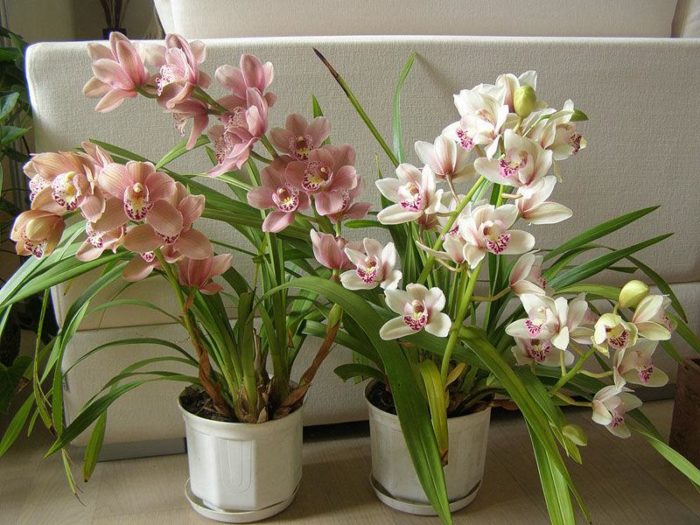
cymbidium orchid description
This species is classified as epiphytic. You can meet it in its natural environment in Australia (in the north of the continent), as well as in subtropical Asia. Most often, the flower can be seen in trees or on rocky soil. Today there are a large number of subspecies of this culture. It is worth taking a closer look at the history of this orchid.
cymbidium orchid origin
For the first time, the culture was brought out in China about 2 thousand years ago. Confucius called representatives of this family the kings of fragrances. And today it is China and Japan that more than other countries cultivate new types of cymbidiums. The fact is that these orchids have a very pleasant aroma during flowering, which is highly prized in Asia.
There are a large number of varieties that differ from each other in the following features:
- height;
- aroma;
- color of buds;
- flowering duration.
Reference. The culture with small flowers is very much appreciated. It looks no less pretty than one large flower.
The classification was first carried out in Japan during the reign of the Muromachi dynasty. This was between the 14th and 15th centuries. However, during the reign of the Edo dynasty, a large number of domestic orchids of this type appeared, so the classification expanded significantly. Today, many flower growers plant this orchid all over the world.
The most detailed description of the cymbidium species was compiled by the Swede Peter Olof Swartz in 1799.
You may also like natural blue orchids.
cymbidium orchid Varieties and types
Today there are quite a few different varieties of the cymbidium orchid. However, they have quite a few differences. It is worth considering the most popular varieties that are grown at home by flower growers around the world.
Dwarf cymbidium
Dwarf cymbidium is considered a fairly popular variety, which today is often grown by gardeners. It has several important features:
- grows in its natural environment on rocky soil at an altitude of about 2 km above sea level;
- the root system is fleshy, outwardly resembles white ropes, which are needed more to fix the plant than to feed it;
- roots grow from oblong pseudobulbs;
- pseudobulbs up to 15 cm high and are quite dense, painted green;
- leaves of a linear type, end with a blunt or rounded edge;
- leaf length can be up to 30 cm;
- on the peduncle up to 20 buds, the diameter of which is about 10 cm;
- one leaf rosette exists for about three years, and then dies and gives way to new leaves;
- the flowering process lasts about a month, usually begins in February;
- lip of white curved type;
- petals of different colors.
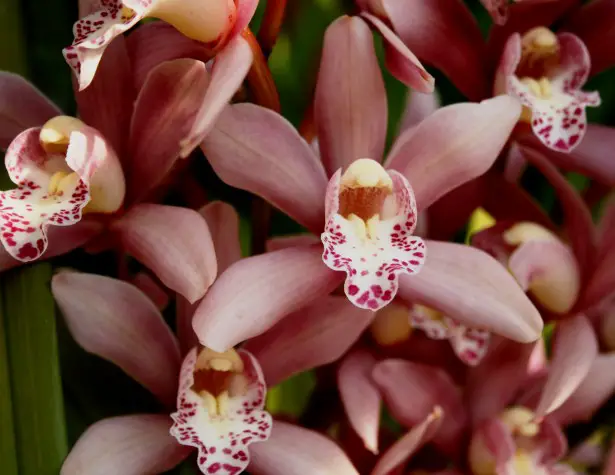
Reference. At home, this plant is never pollinated. It is necessary to create natural conditions for pollination to occur. This means that seed reproduction is not possible.
White Day cymbidium
This epiphytic plant has the following characteristic features:
- leaves are bright green and long;
- peduncles are very thin;
- possibly 15 buds on one peduncle;
- cream-colored flowers about 5 cm in diameter;
- there is a bright red stripe on the petals of the bud;
- the lip is narrow, bent outward.
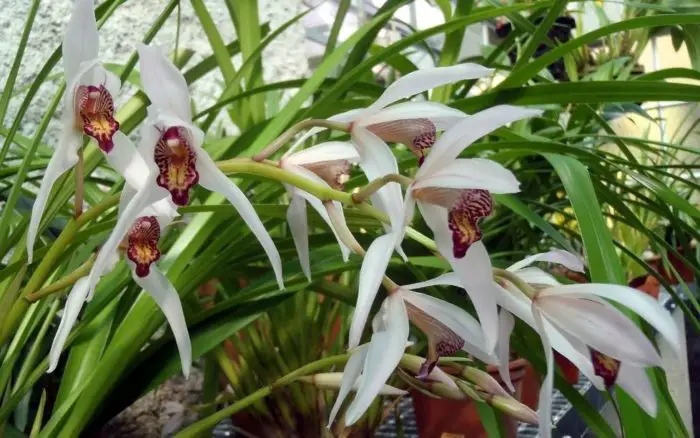
This flower has a pleasant aroma, therefore it is highly valued among plant breeders. However, flowering rarely lasts more than one month.
Take a look at Black Orchids Varieties.
Lowe cymbidium
Low, or low, is a flower that is a typical member of the cymbidium family. However, this variety has several characteristics:
- leaves about 40 cm, narrow;
- peduncles about 45 cm in height;
- on the peduncle up to 15 buds with a diameter of 3 to 6 cm;
- the lip is narrow and has a characteristic protrusion.
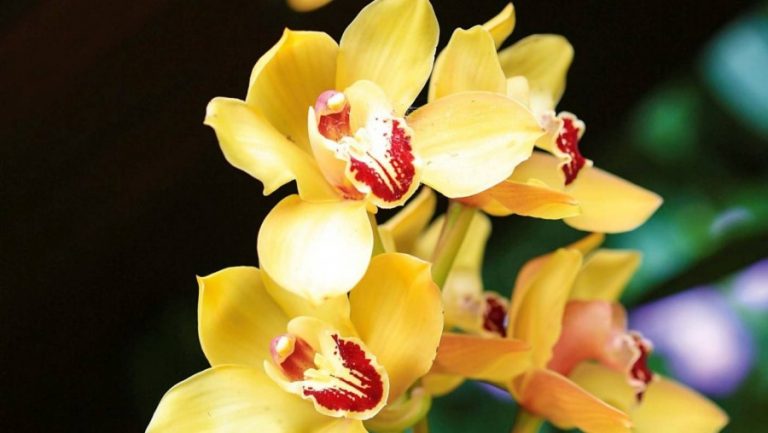
This orchid is considered to be quite cute. It is decorative, takes up little space in the room and feels good at home. It’s a hybrid.
Lanceolate cymbidium
This orchid has the following features:
- bulb up to 15 cm;
- leaves are long, lanceolate, can reach 90 cm;
- peduncle up to 70 cm high;
- on the peduncle there are from 5 to 15 buds, which are about 7 cm in diameter.
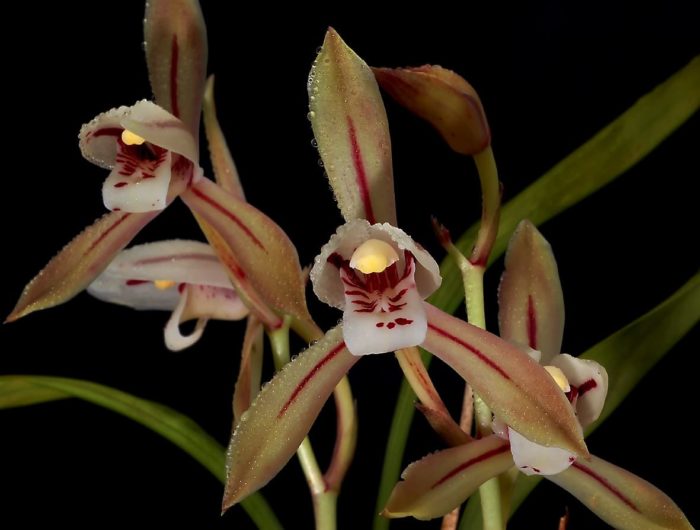
The plant is quite beautiful, perfectly adapted to living in an apartment.
You may also like Oncidium Orchid Varieties.
Giant cymbidium
An excellent plant that is often grown by flower growers around the world. Here are its characteristics:
- the bulb is ovoid, about 15 cm;
- on the bulb there are scaly leaves;
- leaves of a linear-lanceolate type, have a pointed end, about 60 cm long;
- the peduncle is massive and rather strong, its height is up to 60 cm;
- up to 15 buds can be on the peduncle;
- the diameter of the buds is about 12 cm;
- the petals of the buds are yellow-green;
- the lip is cream-colored, wavy, on it you can find shapeless spots of red-brown color.

A very beautiful plant that blooms profusely and emits a pleasant aroma. But it is necessary to create ideal conditions for producing buds.
What are features of cymbidium orchids?
There are several features of all cymbidium orchids:
- the leaves are long and narrow, can reach 90 cm in length, and they are about 5 cm wide;
- leaves are green, may have small scales, pointed and blunt ends are possible;
- flowers can be of different shades, while their size is from 3 to 7 cm in diameter;
- up to 15 buds on the peduncle;
- the root system is well developed, but it is more designed for the flower to hold on to the soil, and it does not absorb nutrients very well.
Reference. This culture feels good in the apartment. There are a large number of varieties that are successfully bred by flower growers today.
cymbidium orchid care and maintenance
It is required to properly care for the culture so that it feels great, grows quickly and blooms profusely. Basically, the latter is of greatest interest to florists.
In order for the cymbidium orchid to feel comfortable, it needs to provide:
- timely watering;
- required temperature conditions;
- regular feeding.
How often do you water cymbidium orchids?
It is very important to water the crop properly. If this action is performed incorrectly, the plant will begin to wilt from lack of moisture. If there is too much of it, the process of decay will begin, which will lead to the death of the culture. Check also What is Miltoniopsis Orchids?
Here are some cymbidium watering rules:
- it is necessary to moisten the soil as its top layer dries;
- in intense light, water about twice a week;
- after 15–20 minutes, all the water that will be in the pan after watering is removed.
Important. You need to find the optimal watering rate, given the size of the pot and plant. This can only be done empirically, there are no recommendations here.
How much sun do cymbidium orchids need?
Cymbidium orchids are very fond of light, but they do not tolerate exposure to direct sunlight. That is why they prefer to grow in partial shade in their natural environment.
Here are some guidelines for choosing where to place your plant pot:
- east or west window;
- diffused light;
- a decrease or increase in daylight hours should occur gradually, otherwise the plant will begin to shed its leaves.
Important. Residents of the northern regions are forced to use a UV lamp in order to artificially extend the daylight hours for the plant. This is due to geographical features. There the sun sets quite quickly in winter, which is not very good for an orchid.
Recommended for you Where To Put Orchids In Your Home?
What temperatures can orchids tolerate?
Cymbidium is a tropical plant. Thus, it can be assumed that he loves warmth. If we talk about specific temperature values, then they are as follows:
- up to +27 degrees during the day;
- at least +18 degrees at night;
- differences should not be sharp, more than 5 degrees.
Reference. If the plant lacks warmth, it begins to turn yellow and shed its leaves. The heat of more than +28 degrees exhausts the flower, so it begins to dry out quickly. Appropriate action should be taken to reduce the indoor temperature. However, the orchid is afraid of the winds. Thus, during ventilation, it must be protected from the effects of air currents. To do this, you can put a plastic bottle cap on it.
Humidity level for cymbidium
This orchid prefers a humidity of 80 to 90%. Some growers specifically install humidifiers in the room where the flower is. However, this is relevant for commercial cultivation of culture. There is also a cheaper way to solve the problem: put a container of water next to the pot.
What do you feed cymbidium orchids?
An orchid, like any other flower, periodically needs feeding. However, fertilization is required correctly. It is recommended to purchase minerals in specialized stores. Make sure that they are suitable for cymbidium orchids.
Here are the basic rules for fertilizing:
- You cannot add minerals immediately after buying a flower: it must stand for a couple of days in a semi-dark place without watering in order to acclimatize.
- Fertilizers are applied exclusively in liquid form.
- It is necessary to add minerals during the period of active growth, budding and flowering.
- The frequency of minerals is 20 days.
Reference. Some growers do not use mineral fertilizers. But for normal growth and good flowering, then frequent transplantation of the plant into enriched soil is necessary.
cymbidium orchid repotting
The orchid transplant process is standard and consists of the following:
- first you need to disinfect the pot;
- then a drainage layer is laid out in it;
- then you need to pour the prepared mixture into it;
- plant an orchid;
- you also need to sprinkle the flower with earth on top.
As for the breeding process, it must be remembered that pollination does not occur in the apartment. That is, the seeds cannot be used. However, you can divide the bush or cuttings. As a cutting it is necessary to use a peduncle, which is cut off at the base of the plant. In this case, it must be divided into parts of about 10 cm. It is advisable to try to germinate each of them, since not all of them give roots.
Possible mistakes in growing cymbidium orchid
There are a few common mistakes beginners face. As a result, the flower gradually dies if the care for it does not change.
- Lack of feeding and transplanting. When the soil is depleted, the crop gradually slows down and begins to wilt.
- Excess moisture. Because of this, the roots begin to rot. They will only be helped by physically removing traces of rot and transplanting into another pot.
- Using an opaque pot or the wrong soil. All this leads to the death of culture.
- Airing the room without protecting the orchid. The leaves turn yellow and fall off.
It is required to properly care for the cymbidium orchid. It reacts quickly to any errors and begins to actively fade. No need to guess what the problem is. It is better to read the rules of care and compare with the actual actions. This will quickly resolve the issue.
